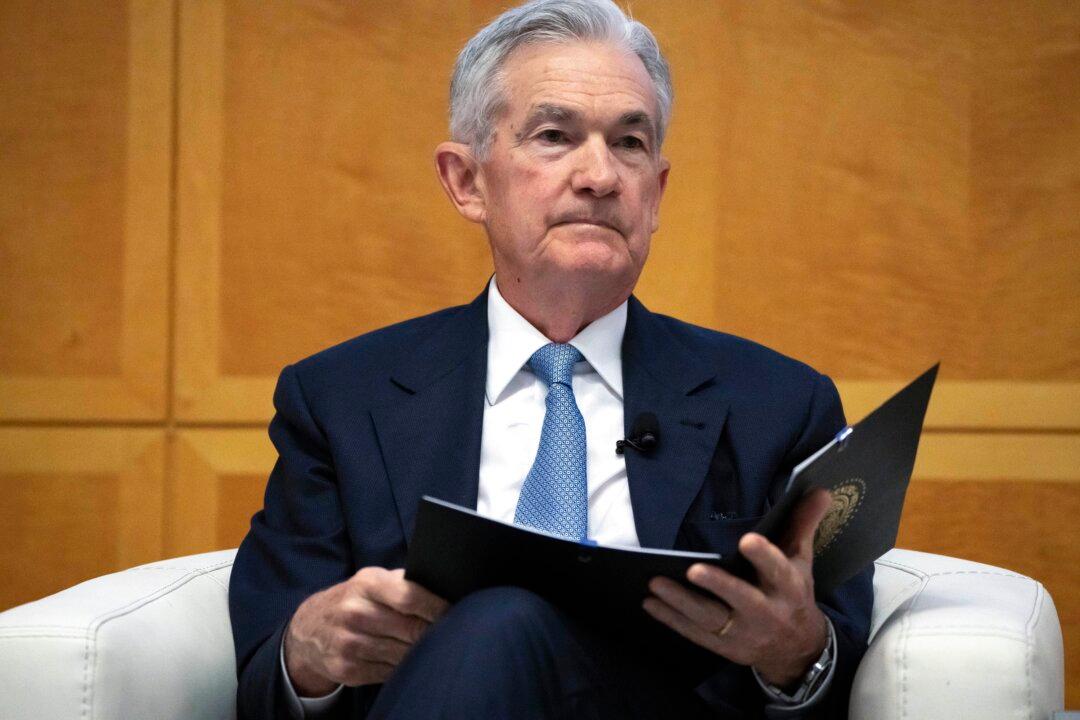The Federal Reserve left interest rates unchanged at the first policy meeting of 2024, signaling that officials might not reduce the benchmark federal funds rate “until there is greater confidence” that inflation is inching toward the central bank’s target rate of 2 percent.
It’s unlikely that the central bank will pull the trigger on a rate cut in March, Fed Chair Jerome Powell told reporters during the post-Federal Open Market Committee (FOMC) meeting news conference.
“Based on the meeting today, I don’t think likely we will have a rate cut in March,” he said.
FOMC members noted that the U.S. economy has been expanding and the labor market has moderated but remains strong.
“Inflation has eased over the past year but remains elevated,” the Fed said in a statement.
Investors paid close attention to the mixed messaging in the rate-setting Committee’s language. Policymakers adjusted their tightening stance while also suggesting that they may not slash interest rates.
“In considering any adjustments to the target range for the federal funds rate, the Committee will carefully assess incoming data, the evolving outlook, and the balance of risks,” the FOMC statement reads. “The Committee does not expect it will be appropriate to reduce the target range until it has gained greater confidence that inflation is moving sustainably toward 2 percent.”
Soft Landing
Contradicting the White House’s economic position on the issue, Mr. Powell argued that the U.S. economy hasn’t yet achieved a soft landing.“I would not say we have achieved a soft landing yet,” he said. “We have a ways to go to achieve a soft landing. We are not declaring victory.”
That said, the base case for the Fed is that the economy is healthy with a solid labor market, meaning that “we can be careful as we think about rate cut timing,” Mr. Powell said.
“The economy is broadly normalizing,” he said.
Mr. Powell noted that much of the reported economic growth “is due to post-pandemic healing” and “when that peters out, our restrictive rate will show up more sharply.”
When asked if it is safe to dismiss fears of a hard landing, Mr. Powell said, “This is a good economy.” But, looking at the outlook, the Fed expects that the economy will moderate and the labor market will rebalance, while 12-month inflation is getting closer to target.
“Overall, this is a pretty good picture,” he said.
Market Reaction
The financial markets reacted negatively to the indication that the central bank isn’t quite ready to slash interest rates, with the leading benchmark indexes firmly in the red.U.S. Treasury yields pared their losses midweek. The benchmark 10-year yield fell below 4 percent. The two-year traded at about 4.28 percent, while the 30-year bond slipped below 4.23 percent.
The U.S. Dollar Index (DXY), a gauge of the greenback against a basket of currencies, erased its losses and turned positive in the wake of the FOMC statement.
The delay in cutting interest rates isn’t surprising, according to Giuseppe Sette, co-founder and president of financial market research firm Toggle AI.
“The ... Fed is thinking along its tradition: Rates are not cut into an expansion until there’s a clear move south in growth and inflation,” Mr. Sette said in a note. “Until the slowdown, rates are okay to remain well above inflation.”
While inflation has slowed, the Fed is determining if the downward trend is sustainable, according to Greg McBride, chief financial analyst at Bankrate.
“The Fed is certainly pushing back on the notion of a March interest rate cut, dashing investors’ hopes again, but keeping options open and remaining non-committal as a central bank does,” he said in a statement.
“Interest rates took the elevator going up but are going to take the stairs coming down.”
Peter Schiff, chief economist and global strategist at Euro Pacific Capital, warned that “the inflation problem will [become bigger].”
Inflation and Rate Cuts
Because of cooler inflation data, March rate cuts are “back on the table,” said Jay Woods, chief market strategist at Freedom Capital Markets.“Prior to this week’s positive surprise in GDP numbers as well as core [Personal Consumption Expenditures (PCE)] sinking below the Fed’s desired rate of 2.0 percent, there was a 50/50 chance of a rate cut in March. Now the data suggest cuts are back on the table,” Mr. Woods said in a note.
Investors are pricing in a 60 percent chance of a rate cut at the FOMC policy meeting in March, according to the CME FedWatch Tool.
In the fourth quarter of 2023, the Fed’s preferred inflation gauge—the PCE price index and core PCE—showed progress.
PCE prices eased to 1.7 percent, down from 2.6 percent in the third quarter. Core PCE, which strips the volatile energy and food components, was flat at 2 percent during the October–December 2023 period.
Others aren’t as confident as the futures market that the central bank will pull the trigger on a rate cut as early as March.
“The Federal Reserve stands pat in March and keeps rates unchanged,” Jeff Klingelhofer, co-head of investments at Thornburg Investment Management, wrote in an analyst note. “The market expects the Fed to cut rates proactively, but their well-telegraphed data dependency gives them pause.”
The Balance Sheet
The FOMC statement noted that the Fed will continue to reduce its holdings of Treasury securities, agency debt, and mortgage-backed securities.When the coronavirus pandemic struck the country, the U.S. central bank sprang into action by slashing interest rates to zero and boosting the money supply by more than $6 trillion. In addition, the Fed expanded its balance sheet to nearly $9 trillion by acquiring Treasury securities, corporate bonds, and mortgage-backed securities.
After initiating the institution’s quantitative-tightening program nearly two years ago, policymakers began reducing its balance sheet holdings.
For the week ending Jan. 25, the Fed’s total assets stood below $7.7 trillion—still 83 percent above the pre-crisis level.
It’s unclear what the monetary authorities’ endgame is for the balance sheet, whether a target date or a specific level. Several Fed officials have recently discussed what should occur this year.
“I would say sometime this year will be a reasonable thing to start thinking about it,” Mr. Waller said.
Lorie Logan, president of the Federal Reserve Bank of Dallas, noted during an International Banking, Economics, and Finance Association meeting on Jan. 6 that the central bank could decelerate the balance sheet runoffs to expand the initiative and diminish the odds of having “to stop prematurely.”
“Normalizing the balance sheet more slowly can actually help get to a more efficient balance sheet in the long run by smoothing redistribution and reducing the likelihood that we’d have to stop prematurely,” she said in prepared remarks.
While all of the focus has been on interest rates, economists purport that the balance sheet also matters to financial markets.
In November 2023, Fed Chair Jerome Powell conceded that quantitative tightening has contributed to the jump in long-term bond yields.
The 20- and 30-year Treasury yields have roughly doubled since the Fed’s tapering campaign was launched to above 4 percent.
Moreover, a June 2022 study by staff economists projected that a $2.5 trillion balance-sheet reduction equals a half-percent bump to the policy rate.
“Overall, the model predicts that reducing the size of the balance sheet by about $2.5 trillion over the next few years, as opposed to maintaining the size at its peak level, would be roughly equivalent to raising the policy rate a little more than 50 basis points on a sustained basis,” they wrote.
Reports suggest that the Fed plans to unveil a plan and communicate it to the financial markets. Until then, investors will have to navigate through the uncertainty and turbulence.
FOMC members will begin “in-depth” discussions surrounding the balance sheet runoff, Mr. Powell confirmed to reporters.







